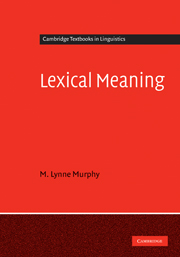Book contents
- Frontmatter
- Contents
- List of figures
- Preface: using this book
- Acknowledgments
- Typographical conventions
- Part I Meaning and the lexicon
- Part II Relations among words and senses
- 5 Meaning variation: polysemy, homonymy, and vagueness
- 6 Lexical and semantic relations
- Part III Word classes and semantic types
- References
- Index
5 - Meaning variation: polysemy, homonymy, and vagueness
from Part II - Relations among words and senses
Published online by Cambridge University Press: 05 June 2012
- Frontmatter
- Contents
- List of figures
- Preface: using this book
- Acknowledgments
- Typographical conventions
- Part I Meaning and the lexicon
- Part II Relations among words and senses
- 5 Meaning variation: polysemy, homonymy, and vagueness
- 6 Lexical and semantic relations
- Part III Word classes and semantic types
- References
- Index
Summary
Key words:
vague, indeterminate, ambiguity, homonymy, polysemy, zeugma, regular (systematic) polysemy, metonymy, metaphor, monosemy, coercion
Overview
In this chapter we turn our attention to an issue we set aside earlier: the fact that in different contexts the same word form can be understood to have different semantic interpretations. For instance book can mean ‘a collection of pages that are bound in a rigid cover’ (hand me that book), ‘the information contained in a collection of pages that are bound in a rigid cover’ (that book is depressing) or ‘reserve’ (We want to book a table for four), and in any of its senses book can point to lots of different kinds of things. For example, the ‘collection of pages’ sense could refer to this book or to a phone book, and the ‘reserve’ sense of book can be used for booking a restaurant by phone or booking a hotel on-line. This chapter reviews three ways in which a single word form can have more than one interpretation: homonymy, polysemy, and vagueness. We'll refer to these three phenomena collectively as cases of meaning variation. After defining the types of meaning variation, we consider whether or not they denote completely distinct phenomena. Next we focus on polysemy (when a single word has several senses) and discuss how words come to have multiple senses and how those senses relate to one another. Finally, we consider how polysemy is treated in two theoretical approaches: the componential approach of Pustejovsky and the frame-based approach of Fillmore.
- Type
- Chapter
- Information
- Lexical Meaning , pp. 83 - 107Publisher: Cambridge University PressPrint publication year: 2010
- 1
- Cited by

